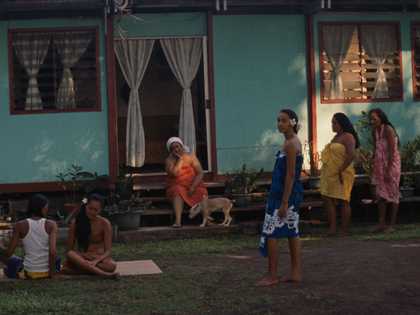Alongside their individual art practices, Rosalind Nashashibi and Lucy Skaer have been making collaborative works since 2005. Ahead of their forthcoming exhibition at Tate St. Ives, the artists join us to present the UK premiere of their short film Why Are You Angry?, followed by a selection of their jointly-made 16mm works. Taking artworks as their starting points, these films explore the transformations and slippages to which images are subject. The screening closes with two films made individually by Nashashibi and Skaer, each portraying artists in their home environment.
The screening is followed by a discussion with the artists and an audience Q&A.
Programme
Nashashibi/Skaer, Why Are You Angry?, United Kingdom / French Polynesia 2017, 16mm transferred to HD, black and white and colour, sound, 18 min
Taking both its title and staged gestures from one of Paul Gauguin’s late paintings, Why Are You Angry? is a meditation on the artist’s representation of women in Tahiti, looking at both the problems and the potentials of imagining women through his particular gaze. The film moves between choreographed and spontaneous footage of Tahitian women in front of their homes, at work and in the artists’ rented apartment.
Nashashibi/Skaer, Our Magnolia, United Kingdom 2009, 16mm, black and white and colour, sound, 5 min
Our Magnolia takes as its starting point Paul Nash’s 1944 painting Flight of the Magnolia, conceived when the threat of a German invasion of England imbued the sky with a new anxiety: the potential to blossom with explosions or parachutes. The film intercuts details of Nash’s aerial magnolia with a series of evocative images referencing Thatcherism and the Iraq War, amid other contexts. Nash’s painting becomes more and more menacing as the film progresses.
Nashashibi/Skaer, Flash in the Metropolitan, United Kingdom 2006, 16mm, colour, silent, 4 min
Shot in 2006 in New York’s Metropolitan Museum of Art, the film tracks through the Near Eastern, African and Oceanic collections, offering fleeting glimpses of statues, bowls and historical artifacts. Lit solely by a flashing strobe, these ancient objects are granted a split second in the limelight, but the metronomic regularity of those flashes reverses the transitory nature of these brief glimpses, hinting in three short minutes at the vast stretches of time that separate the objects.
Nashashibi/Skaer, Pygmalion Event, United Kingdom 2008, colour, silent, 16mm double screen projection, 4 min
This Tate-commissioned double screen work explores transitions in the process of cognition. The left screen shows the priest of the Matisse-designed Rosary Chapel as he puts on the artist’s colourful robes and presents them to the viewer. The right screen unspools a series of colours, landscapes and pictograms that appear to react by associative logic to the scene on the left screen, adding a formal commentary to the narrative structure of the film.
Lucy Skaer, Leonora (The Joker), United Kingdom 2006, 16mm, colour, silent, 1 min
Skaer’s portrait of a then-elderly Surrealist painter Leonora Carrington (1917–2011) studies her wrinkled hands and dry, witchy hair, her jars of paint pigment and the cheap plastic clothes-pegs pinned to a laundry line. Though Carrington appears to be speaking throughout, her voice is never heard. At the end of the film, Carrington holds up her finger in a gesture of imminent wisdom; Skaer cuts to black.
Rosalind Nashashibi, Vivian’s Garden, United Kingdom 2017, 16mm transferred to HD, colour, sound, 30 min
Vivian’s Garden takes a close look at the artistic, emotional and economic lives of Vivian Suter and her mother Elisabeth Wild, two Swiss / Austrian émigré artists that developed a matriarchal compound in Panajachel, Guatemala, where they live in the company of two or more Mayan villagers as guardians and maids. This filmic portrait presents both the complexity of the colonial relations within the household as well as the deep sense of care that passes between all characters.
Biographies
Rosalind Nashashibi (b.1973, United Kingdom) is a London-based artist working primarily in film, painting and printmaking. Her films use the camera as an eye to convey moments and events, merging everyday observations with fantastical and mythological elements. Nashashibi represented Scotland in the 52nd Venice Biennale, and her work has been included in Manifesta 7, the Nordic Triennial, Sharjah 10 and Documenta 14. She was the first woman to win the Beck’s Futures prize in 2003 and is this year nominated for the Turner Prize. She is currently Senior Lecturer in Fine Art at Goldsmiths University.
Lucy Skaer (b.1975, United Kingdom) is an artist based in Glasgow and London. Her sculptures, films, paintings and drawings often take found photographic sources as their starting point. Rooted in reality, yet subjected to a process of elaborate transformation, her images hover in the space between recognition and ambiguity, figuration and abstraction. Skaer exhibited at the first Scottish presentation at the Venice Biennale, where she also presented in 2007. She was nominated for both the 2003 Beck's Futures prize and the 2009 Turner Prize, and has exhibited internationally. In addition to the Nashashibi/Skaer collaboration, Skaer is a founding member of Henry VIII's Wives artist collective.

